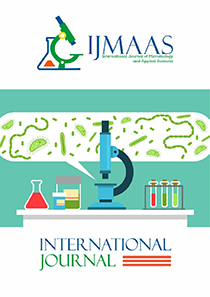Antibiotic Susceptibility of Microorganisms and Proximate Profiles of Minimally Processed Leafy Vegetables Purchased from a University Campus
Vol 1, Issue 1, 2023
KEYWORDS
leafy vegetables, microorganisms, multi-drug resistance, proximate profile, food safety
Abstract
The study assessed the antibiotic susceptibility of microorganisms and proximate profiles of minimally processed leafy vegetables (Telfairia occidentalis and Ocimum gratissimum). The vegetable samples were processed by washing and blanching and analysed for microbiological and proximate parameters using standard protocols. Comparatively, blanched samples had lower microbial load than washed samples. Range of mean values of microbial counts of processed samples was; Aerobic plate count 2.15 – 2.50×103CFU/g; Coliform 0.00 – 8.45×103CFU/g; Salmonella-Shigella 1.20 – 2.05×103CFU/g and fungal count 1.20 -5.50×102CFU/g. These values are below permissible limits for foodstuffs by Food and Agriculture Organization (FAO)/World Health Organization (WHO). Identified microbes and relative abundance (%) were Staphylococcus sp. (25.8), Bacillus and Vibrio species (22.6), Escherichia coli (9.7), Klebsiella and Shigella species (6.5) and Proteus and Salmonella species (3.2) and Alternaria sp (31), Fusarium and Yeast species (24.1) and Penicillium sp (20.7). Proximate composition indicated increased moisture and crude carbohydrate but decreased crude protein, fibre and fat contents after blanching. Susceptibility profile showed that all the Gram-negative bacteria were 100% resistant to Nalidixic acid and Gram positives, 100% resistant to Streptomycin and Amoxil with multiple antibiotic resistance index (MARI) ranging from 0.1-1.0. Seven species including Proteus, Shigella and Staphylococcus depicted high degree of multi-drug resistance (MDR) and five exhibited 83% resistance to Ciproflox and Septrin. Vibrio and Bacillus species were the most susceptible to several drugs with MARI of ≤ 0.2. The incidence of Enterobacteriaceae, Staphylococcus, Bacillus and fungi portends serious health risk to consumers. Therefore, to ensure food safety, good agricultural and food processing practices, personal hygiene, and environmental sanitation monitoring are required of all stakeholders and consumers to minimize outbreak of vegetable-borne diseases.
Current: Vol. 4, Issue 1, 2025

Call for papers
The International Journal of Microbiology and Applied Sciences warmly welcome your valuable articles for publication.
